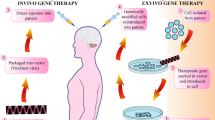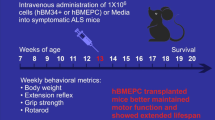Abstract
Current treatment options of chronic, progressive degenerative neuropsychiatric conditions offer only marginal efficacy, and there is no therapy which arrests or even reverses these diseases. Interest in genetic engineering and cell-based approaches have constantly been increasing, although most of them so far proved to be fruitless or at best provided very slight clinical benefit. In the light of the highly complex patho-mechanisms of these maladies, the failure of drugs aimed at targeting single molecules is not surprising. In order to improve their effectiveness, the role of a unique triple-combination gene therapy was investigated in this study. Intravenous injection of human umbilical cord blood mononuclear cell (hUCBMC) cotransduced with adenoviral vectors expressing vascular endothelial growth factor (VEGF), glial cell-derived neurotrophic factor (GDNF), and neural cell adhesion molecule (NCAM) resulted in prominent increase of life span and performance in behavioral tests in amyotrophic lateral sclerosis (ALS). Expression of the recombinant genes in hUCBMCs was confirmed as soon as 5 days after transduction by RT-PCR, and cells were detectable for as long as 1 month after grafting in lumbar spinal cord by immunofluorescent staining. Xenotransplantation of cells into mice blood without any immunosuppression demonstrated a high level of hUCBMCs homing and survivability in the central nervous system (CNS), most conspicuously in the spinal cord, but not in the spleen or liver. This study confirms an increased addressed homing and notable survivability of triple-transfected cells in lumbar spinal cord, yielding a remarkably enhanced therapeutic potential of hUCBMCs overexpressing neurotrophic factors.






Similar content being viewed by others
References
Lim ST, Airavaara M, Harvey BK (2010) Viral vectors for neurotrophic factor delivery: a gene therapy approach for neurodegenerative diseases of the CNS. Pharmacol Res 61:14–26
McGinley LM, Sims E, Lunn JS, Kashlan ON, Chen KS, Bruno ES, Pacut CM, Hazel T, Johe K, Sakowsski SA, Feldman EL (2016) Human cortical neural stem cells expressing insulin-like growth factor-I: a novel cellular therapy for Alzheimer’s disease. Stem Cells Transl Med 5:1–13
Kumagai G, Tsoulfas P, Toh S, McNiece I, Bramlett HM, Dalton WD (2013) Genetically modified mesenchymal stem cells (MSCs) promote axonal regeneration and prevent hypersensitivity after spinal cord injury. Exp Neurol 248:369–380
Jingzhong Z, Hui Y, Deyi D, Chunli D, Chunli Z, Xiaohong S, Jinlu Z, Qunyuan X (2005) Long-term therapeutic effects on parkinsonian rats of intrastriatal co-grafts with genetically engineered fibroblasts expressing tyrosine hydroxylase and glial cell line-derived neurotrophic factor. Int J Neurosci 115(6):769–779
Ou Y, Yu S, Kaneko Y, Tajiri N, Bae EC, Chheda SH, Stahl CE, Yang T, Fang L, Hu K, Borlongan CV, Yu G (2010) Intravenous infusion of GDNF gene-modified human umbilical cord blood CD34+ cells protects against cerebral ischemic injury in spontaneously hypertensive rats. Brain Res 1366:217–225
Iancu C, Ilie I, Mocan L, Georgescu C, Ilie R, Duncea I, Mocan T, Iancu D et al (2011) Human cord blood-derived stem cells in transplantation and regenerative medicine. Stem Cells in Clinic and Research. InTech. Available from: http://www.intechopen.com/books/stem-cells-in-clinic-and-research/humancordblood-derived-stem-cells-in-transplantation-and-regenerative-medicine
Ding DC, Chang YH, Shyu WC, Lin SZ (2015) Human umbilical cord mesenchymal stem cells: a new era for stem cell therapy. Cell Transplant 24(3):339–347
Islamov RR, Rizvanov AA, Mukhamedyarov MA, Salafutdinov II, Garanina EE, Fedotova VY, Solovyeva VV, Mukhamedshina YO, Safiullov ZZ, Izmailov AA, Guseva DS, Zefirov AL, Kiyasov AP, Palotás A (2015) Symptomatic improvement, increased life-span and sustained cell homing in amyotrophic lateral sclerosis after transplantation of human umbilical cord blood cells genetically modified with adeno-viral vectors expressing a neuro-protective factor and a neural cell adhesion molecule. Curr Gene Ther 15(3):266–276
Weydt P, Hong SY, Kliot M, Moller T (2003) Assessing disease onset and progression in the SOD1 mouse model of ALS. Neuroreport 14(7):1051–1054
O’Connor DM, Boulis NM (2012) Cellular and molecular approaches to motor neuron therapy in amyotrophic lateral sclerosis and spinal muscular atrophy. Neurosci Lett 527(2):78–84
Sun T, Ma QH (2013) Repairing neural injuries using human umbilical cord blood. Mol Neurobiol 47(3):938–945
Garbuzova-Davis S, Rodrigues MC, Mirtyl S, Turner S (2012) Multiple intravenous administrations of human umbilical cord blood cells benefit in a mouse model of ALS. PLoS One 7(2):e31254
Shen Y, Muramatsu SI, Ikeguchi K, Fujimoto KI, Fan DS, Ogawa M, Mizukami H, Urabe M, Kume A, Nagatsu I, Urano F, Suzuki T, Ichinose H, Nagatsu T, Monahan J, Nakano I (2004) Ozawa K. Triple transduction with adeno-associated virus vectors expressing tyrosine hydroxylase, aromatic-L-amino-acid decarboxylase, and GTP cyclohydrolase I for gene therapy of Parkinson’s disease. Hum Gene Ther 11(11):1509–1519
Krakora D, Mulcrone P, Meyer M, Lewis C (2013) Synergistic effects of GDNF and VEGF on lifespan and disease progression in a familial ALS rat model. Mol Ther 21(8):1602–1610
Acknowledgments
This study was supported by the grant of Russian Science Foundation no. 16-15-00010. The work is performed according to the Russian Government Program of Competitive Growth of Kazan Federal University and subsidy allocated to Kazan Federal University for the state assignment in the sphere of scientific activities. Some of the experiments were conducted using the equipment of interdisciplinary center for collective use of Kazan Federal University supported by Ministry of Education of Russia (ID RFMEFI59414X0003), Interdisciplinary Center for Analytical Microscopy and Pharmaceutical Research and Education Center, Kazan (Volga Region) Federal University, Kazan, Russia.
Author information
Authors and Affiliations
Corresponding authors
Rights and permissions
About this article
Cite this article
Islamov, R.R., Rizvanov, A.A., Fedotova, V.Y. et al. Tandem Delivery of Multiple Therapeutic Genes Using Umbilical Cord Blood Cells Improves Symptomatic Outcomes in ALS. Mol Neurobiol 54, 4756–4763 (2017). https://doi.org/10.1007/s12035-016-0017-x
Received:
Accepted:
Published:
Issue Date:
DOI: https://doi.org/10.1007/s12035-016-0017-x




